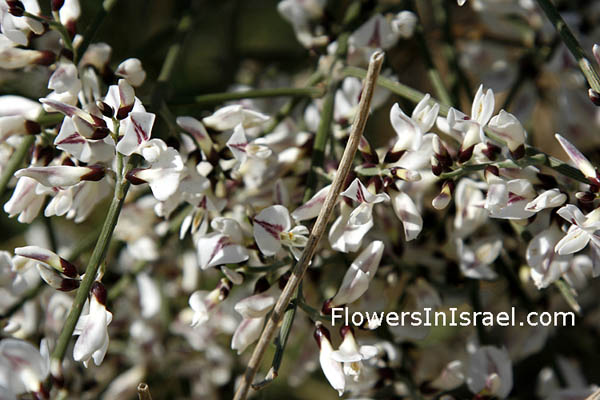White Broom, White Weeping Broom,
Hebrew: רותם המדבר, Arabic: رتم,
| Scientific name: | Retama raetam (Forssk.) Webb | |
| Synonym name: | Lygos raetam (Forssk.) Heyw., Feddes Repert. | |
| Common name: | White Broom | |
| Hebrew name: | רותם המדבר, Rothem | |
| Arabic name: | رتم, Ratam | |
| Family: | Papilionaceae, פרפרניים |

|
| Life form: | Phanerophyte shrub | |
| Stems: | To about 3 m tall and may reach 6 m across; short trunk branching from the base; stems of young plants are covered with long soft hairs but become hairless with age; drooping branches | |
| Leaves: | Alternate, entire, very small (about 5 mm long) and narrow (only 1 mm wide), are quickly dropped and the plant remains leafless for most of the year | |
| Inflorescence: | Dense racemes | |
| Flowers: | White, pea-like, appearing close to the stems in clusters of 3–15; each flower tube contains ten stamens, the pollen bearing stalks that are the male reproductive parts of the flower | |
| Fruits / pods: | One- or two-seeded pods, which do not open when mature, but feall on the ground | |
| Flowering Period: | February, March, April | |
| Habitat: | Sand | |
| Distribution: | The Mediterranean Woodlands and Shrublands, Semi-steppe shrublands, Shrub-steppes, Deserts and extreme deserts | |
| Chorotype: | Saharo-Arabian | |
| Summer shedding: | Perennating |

Derivation of the botanical name: Retama, the Hebrew word rotem רותם, seems to be the same as the Arabic word retem, and the retama of the Moors. Rotem, retem, or retama in Arabic defines a string tied around the finger as a reminder. An Arab explanation of the definition and the source of the name, is said that rotem designates a ribbon which the Arabs tie before embarking on a journey. If, upon their return they find the ribbon as they left it, they assume from this that their lovers have not been unfaithful, if the oposite is true - it is a sign that she has betrayed him. It is said that the ribbon is tied only onto a rotem (Retama). The Hebrew name: “rotem” or “rothem” and “r'tamin”, and “ritmah” or “rithmah” (Greek, ραϑμεν) is translated “juniper”, but is a species of broom known as the white broom, Retama raetam. The name Rithmah—a place along the route of the Exodus (Numbers 33:18-19)—was named for this shrub (rothem).
Retama raetam is a “stem-assimilant, the green stem does much of the photosynthesizing, especially during the dry season. Fruits and flowers provide forage for goats. The stems provide fuel directly and are also converted to charcoal. It makes up an important part of the fuel supply for Late Bronze and Iron Age copper smelting. Charcoal remains (40% was Retama raetam) were analysed from copper ore smelting at Khirbet en-Nahas, an Iron Age site in the region of Feinan between Wadi Arabah, Aravah (Hebrew: הָעֲרָבָה, HaArava; Arabic: وادي عربة, Wādī ‘Araba) and the highland of Edom. Radiocarbon dates from the charcoal range from the 12th to the 9th century B.C. Dr. Aref Abu Rabia, Ben-Gurion University, Be'er Sheva, noted that the Bedouins boil the leaves of Retama raetam (‘ratamals’) in water and use the brew to wash wounds and inflammations. Animals are made to drink this brew as a medicine for brucellosis (an infectious disease caused by contact with animals carrying bacteria called Brucella). At bedouin marriages and other celebrations the bedouins fasten sprigs of green plants, such as the Retama raetam, to the entrance of the tent. Green, the color of live plants, is a symbol of life and vitality. See the list of Medicinal herbs in Israel, the parts used and their medical uses to treat various diseases. Pollinators: Bees, Insects Bible resources:



|